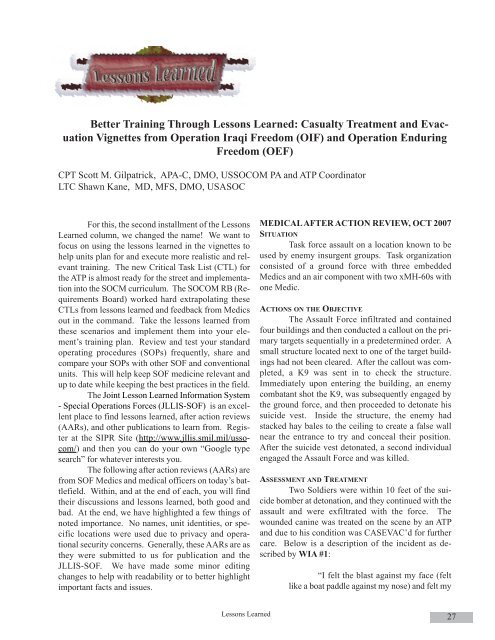Spring 07 front cover - United States Special Operations Command
Spring 07 front cover - United States Special Operations Command
Spring 07 front cover - United States Special Operations Command
- No tags were found...
Create successful ePaper yourself
Turn your PDF publications into a flip-book with our unique Google optimized e-Paper software.
Better Training Through Lessons Learned: Casualty Treatment and EvacuationVignettes from Operation Iraqi Freedom (OIF) and Operation EnduringFreedom (OEF)CPT Scott M. Gilpatrick, APA-C, DMO, USSOCOM PA and ATP CoordinatorLTC Shawn Kane, MD, MFS, DMO, USASOCFor this, the second installment of the LessonsLearned column, we changed the name! We want tofocus on using the lessons learned in the vignettes tohelp units plan for and execute more realistic and relevanttraining. The new Critical Task List (CTL) forthe ATP is almost ready for the street and implementationinto the SOCM curriculum. The SOCOM RB (RequirementsBoard) worked hard extrapolating theseCTLs from lessons learned and feedback from Medicsout in the command. Take the lessons learned fromthese scenarios and implement them into your element’straining plan. Review and test your standardoperating procedures (SOPs) frequently, share andcompare your SOPs with other SOF and conventionalunits. This will help keep SOF medicine relevant andup to date while keeping the best practices in the field.The Joint Lesson Learned Information System- <strong>Special</strong> <strong>Operations</strong> Forces (JLLIS-SOF) is an excellentplace to find lessons learned, after action reviews(AARs), and other publications to learn from. Registerat the SIPR Site (http://www.jllis.smil.mil/ussocom/)and then you can do your own “Google typesearch” for whatever interests you.The following after action reviews (AARs) arefrom SOF Medics and medical officers on today’s battlefield.Within, and at the end of each, you will findtheir discussions and lessons learned, both good andbad. At the end, we have highlighted a few things ofnoted importance. No names, unit identities, or specificlocations were used due to privacy and operationalsecurity concerns. Generally, these AARs are asthey were submitted to us for publication and theJLLIS-SOF. We have made some minor editingchanges to help with readability or to better highlightimportant facts and issues.MEDICAL AFTER ACTION REVIEW, OCT 20<strong>07</strong>SITUATIONTask force assault on a location known to beused by enemy insurgent groups. Task organizationconsisted of a ground force with three embeddedMedics and an air component with two xMH-60s withone Medic.ACTIONS ON THE OBJECTIVEThe Assault Force infiltrated and containedfour buildings and then conducted a callout on the primarytargets sequentially in a predetermined order. Asmall structure located next to one of the target buildingshad not been cleared. After the callout was completed,a K9 was sent in to check the structure.Immediately upon entering the building, an enemycombatant shot the K9, was subsequently engaged bythe ground force, and then proceeded to detonate hissuicide vest. Inside the structure, the enemy hadstacked hay bales to the ceiling to create a false wallnear the entrance to try and conceal their position.After the suicide vest detonated, a second individualengaged the Assault Force and was killed.ASSESSMENT AND TREATMENTTwo Soldiers were within 10 feet of the suicidebomber at detonation, and they continued with theassault and were exfiltrated with the force. Thewounded canine was treated on the scene by an ATPand due to his condition was CASEVAC’d for furthercare. Below is a description of the incident as describedby WIA #1:“I felt the blast against my face (feltlike a boat paddle against my nose) and felt myLessons Learned 27
















